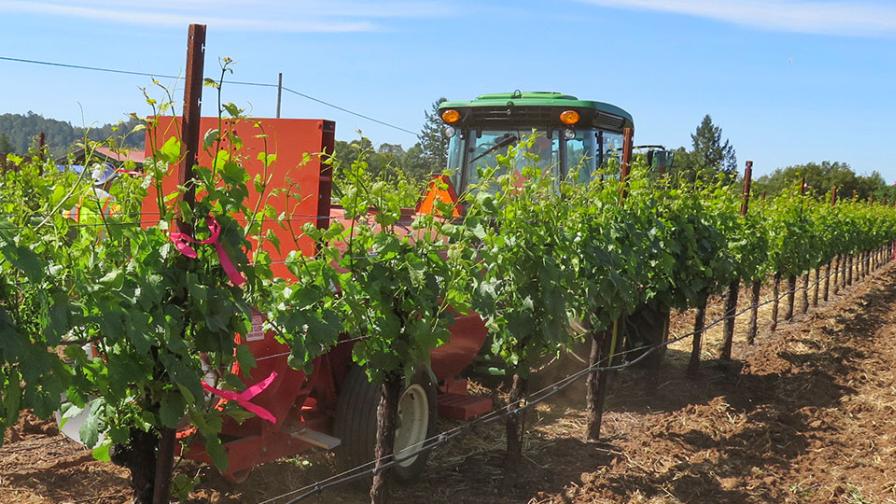Proper Management of Powdery Mildew in Grapes: The Fanfare Behind Sprayers

Where the air goes, so goes the spray drops. The flutter of flagging tape helps growers determine the ideal tractor and sprayer speed. An angle of 25 to 45 degrees is preferred, especially in the fight against plant diseases like powdery mildew in grapes.
Photo by Lynn Wunderlich/UC Regents
The road to proper management of powdery mildew in grapes would be a lot smoother if growers could set sprayers to one speed all season. But the foliage goalposts — from bud break to harvest — are always moving, which creates a challenge.
Canopy density is vital to determining sprayer speed, according to Lynn Wunderlich, a University of California Cooperative Extension Farm Advisor in the Central Sierra Nevada. Unfortunately, sprayer calibrations are often performed only at the beginning of the season or during the dormant season, when there is no canopy.
“Because of that, we’re really missing an opportunity to optimize our sprayers and our spray coverage,” Wunderlich says.
Growers can avoid the problem, Wunderlich says, by setting and measuring proper speeds in conjunction with determining current canopy growth. They also need to focus on sprayer fans, she adds.
“Proper ground speed is really the interpretation of the consideration of the speed, the canopy, and the sprayer fan. Those three things determine proper ground speed,” she says.
Unfortunately, sprayer fans can be both “friend and foe,” Wunderlich says. On the plus side, fans transport droplets into canopies. They also open up canopies to increase spray penetration. With some sprayers, such as Air-Shear, the fan actually creates, or atomizes, the droplets, she says.
“But there is a cost to that,” she notes.
Growers need power to move the fans. “It’s a great suck for our horsepower because the fan needs to work against drag,” Wunderlich says.
If too much air winds up being present — for example, if the fan is too big, or if the canopy is too small, or the grower is driving too slow — sprayers might “blast” droplets right through the canopy, Wunderlich says, and create shingling, in which the leaves are layered on top of each other, preventing penetration inside the canopy.
If too little air is present — if the fan is too small, or the canopy is too big, or the driver is moving too fast — the application will not be effective, she adds.
Simple Solution
The ideal way to determine proper speeds — a $3 role of flagging tape — sounds too good to be true, Wunderlich says. “It’s true that something as simple as flagging tape is probably one of the most critical pieces of equipment that you need to properly calibrate, in addition to water-sensitive paper,” she says.
Growers should tie the flagging tape on the canopy side opposite from which the tractor and sprayer are travelling.
“You drive down the aisle row at the determined speed that we think we want to use, with the fan setting at what we think we want to use, and we observe how the tape flutters,” Wunderlich says. “That tells us something about how the air is penetrating the canopy. Where the air goes, the spray drops are going to go.”
If the ribbons are flying at angles between 45 and 90 degrees, there is too much air, or the air is going too fast. “We want to decrease the fan or drive faster,” Wunderlich says. If they are flying at less than 25 degrees, the call is to increase the fan or drive slower.
“What we want is 25 to 45 degrees. I’m happy with how that flagging is fluttering,” Wunderlich says. “The air is getting through the canopy but is not being pushed through too forcefully.”
Sprayer Settings
Ironically, early-season sprays are a good time to consider using larger droplets and less fan for ideal coverage, Wunderlich says.
“You’d think it would be so easy to get good coverage early season, but in reality, we’re lacking the canopy to capture our spray,” she says. “So, we need to think strategically about our early settings. And this is a key, key time for mildew control. This is what sets the game for the whole season.”
Slower air is desirable, Wunderlich advises, because it provides better coverage on the backside of foliage. This can be achieved with either a fan gearbox or using the decades-old strategy of gear up, throttle down (GUTD), in which the tractor is set to a higher gear but lower engine speed, thus slowing the fan.
With regard to options for large droplets, low-drift nozzles are now available for hydraulic nozzle sprayers. “We don’t yet see these used much in California, but I’m here to tell you they are an option for you,” Wunderlich says.
Larger drops are favorable, she says, because small drops move easily off target and also evaporate more easily. Citing new research by Jason Deveau, aka the “Spray Guy,” she notes that droplets can evaporate to a third of their original size in mere seconds.
Are low-drift nozzles effective? Wunderlich, upon conducting her own study in 2020, determined that powdery mildew prevalence and severity with air-induction nozzles used for the first three sprays was not significantly different than the powdery mildew prevalence with conventional nozzles used all season.
“You have an option now,” she says.
Finally, Wunderlich recommends verifying sprayer settings with water-sensitive paper. “It’s more readily available now,” she says. “I like to put it where I want to see pest control.”
For those interested in learning more about adjusting their speed and air for better spray coverage, Wunderlich and colleague Franz Niederholzer (UCCE Yuba/Sutter/Colusa) have worked with UCIPM online course experts to develop an interactive training. The course is available for free (no CEUs) or a fee (2.5 CEU’s, 2 “other” and 0.5 “laws”) and can be found via http://ipm.ucanr.edu/training/index.html.










